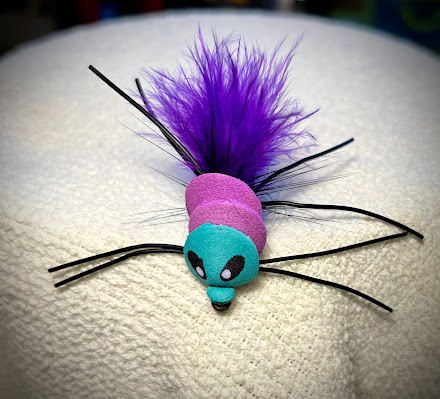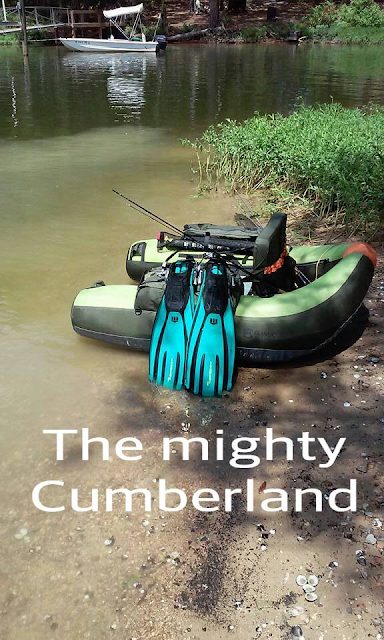I
met a man today and proved to him I am crazy!
------ <~~> ------
“Excuse me. What's that
sticker in the window of your truck?”
I
turned and saw a middle aged man in the parking spot next to me,
sitting in his car. He had the look of a man waiting for his wife.
“What is 'Palmetto Fly N Fish'? You into
airplanes? Fly Fishing?”
“Fly fishing, in fact,” I
replied. “See the Facebook symbol? It's a Facebook group. You
should check us out.”
“Well, okay, really?... fly fishing, huh? There isn't much of that around here, is
there?”
“Plenty! There is water everywhere. But if you mean are there many people doing it - no, not really. A few, but just a few.
South
Carolina isn't exactly a hot bed of fly fishing action. I get a lot
of odd looks and comments about it. Stuff like...
'Fly
Fishing? Can you do that here?'
'Is that legal?'
'There aint no
trout around here...'
I've heard all these and more. If isn't a
Beetle Spin, Zebco reel, or bass lure, well....it throws people off balance.”
“But you go for bass and striper, right? That's
something worthwhile.”
BOOM! There it was. *Something worthwhile.*
I could see where
this was heading, so I played along.
“I'll go for bass if I
think it's the thing to do; it depends on the conditions. I'm always
ready for them, but I'm not always after them. Striper on the other
hand, well”... He perked up when he heard the name...
“I consider
them a costly nuisance.
They show up when you least expect themand mess with my kind of fishing. And by costly, I mean I can't afford
the gear, the time, or even the gas for them. Besides, all that Class
A personality stuff isn't really my bag.”
Striper not my
bag? Distaste clouded his face.
He looked me up and down, now; my tie-dye T-shirt and the bandanna cap on
my head cemented his opinion of me as a blaspheming nut.
“So
you mean you just go for brim and PANFISH?? That's it?”
“Yeah,
pretty much. In fact I look forward to this time of year in
particular. This is the time of year for wet wading – that's my
favorite.
“Oh, I gotcha... with waders.” He seemed
relieved to hear something normal come from my mouth.
“Well
– not exactly. I do have waders, but 'wet wading' is where you get
into the water with nothing but a pair of light cotton pants, and
wading boots. Anywhere that lets me access waist deep water with
weeds, wood, or rocks, I'm wading in.
Even when the boat ramps are overrun, and the picnic tables
jam-packed.... I wade in and find quiet and solitude away from the
crowd. I use pajama pants and scuba reef boots for that. The pants
are super light weight, and the scuba boots beat regular wading boots
hands down.... and at 1/3 the cost.”
“Eh...pajama
pants...” he said. He was just short of sneering at this point.
"So
you're fishing t-o-p-w-a-t-e-r” – he drew out the word the way you'd mention a redheaded step-child.
“Oh yes; you
always start with the surface. But there's an entire water column,
from top to bottom, and I fish it all.
On top I might use a
popper, a foam fly, or even a trout fly."
The word, "popper" got me another
pitiful look.
“But the top water bite soon fades out, especially
as the sun climbs high. That's when I switch to subsurface patterns.
Nymphs or soft hackles are especially good for that. Baitfish
mimics, and crawfish patterns work well, too, in the right
areas.”
“You've put a lot of thought into this....” he
observed.
It was said the way a psychiatrist might talk to a patient - in a
straightjacket.
“Well sure - all fish have their ways and
their life cycles. It's more than just trout, after all. And we have
trout here, too, you just have to seek them out. But, I prefer to
fish 15 minutes from my house, so trout aren't usually in my plans.
But there is a Trout Unlimited group over in Columbia*, so there are a
few other fly anglers over that way.”
* Columbia, SC
“Oh, Trout Unlimited... yes,
yes, okay... then you must know Jim Hallberg. Yes, they're good and they
get into some...”
I stopped him and smiled widely.
“No, sorry I don't know
him. The TU folks are money people,... I can't afford them!" I chuckled.
"They are cut from a different
cloth than me, shall we say? Besides they are way over there, so I have never joined.
I'm not really a
joiner, anyway, not in that way.”
Now he was snorting,
the way you do when you feel the other guy is off his rocker.
“So,
do you ever catch anything decent?”
He wasn't hiding his scornful
attitude, now.
I sensed the the time was right, and I went for the
throat....
“Well, today I caught a nice redbreast
off the boat ramp. It came on an old-school bucktail fly, and it led
me around in circles two or three times. I wasn't quite sure what it
was, because it wasn't the rocketing run of a bass, or the throbbing
pulse of a bluegill. It wanted to run, and I let it.
It was a nice surprise; they're beautiful
fish.”
He was sure I was sun-baked, then...anyone happy with a redbreast on a fly rod must be.
Just
then, his wife appeared with that, “who are you talking to,” look
that wives get. He was clearly relieved to be rescued from this tie-dyed kook.
“Well you take care...” he said, and
hastily started the car.
At last, it was time for the coup de grâce, the final blow, ....”Sorry, friend, I didn't catch your name. We
ought to go fishing sometime...'
“Yeah, sure... maybe one of
these days...” he couldn't get away fast enough.
That redbreast really WAS a beautiful fish....
------ <~~> ------
Writers should always strive for a job well done... even half-baked ones like me. So if you found value in this article, please like, comment, and share it.
Do you have questions, compliments, or suggestions?
If so, email me at...dahutist@gmail.com
If you appreciate a no-drama, no-hype Facebook group, follow this link and come join us at: Palmetto Fly n Fish
Thanks so much for reading, and...
Tight Lines,
Dave Hutton
© All rights reserved, David Hutton/Palmetto Fly N Fish 2023

































